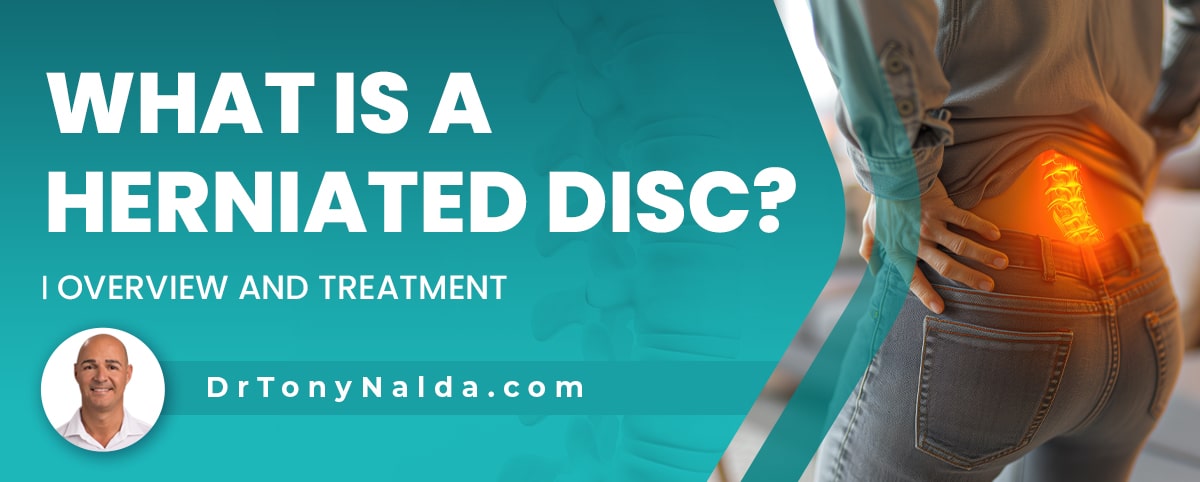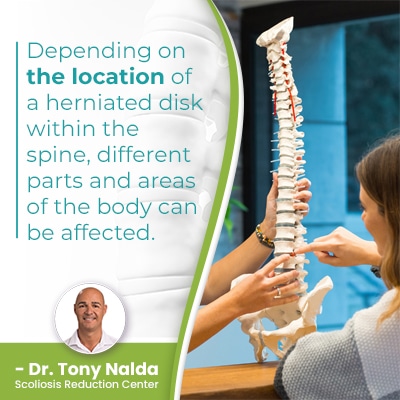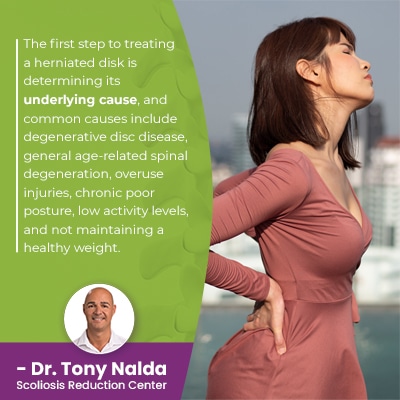What Is a Herniated Disc? Overview and Treatment

The spine's individual parts have to work together to maintain optimal spinal health and function, and this includes its discs. A disc sits between adjacent vertebrae and gives the spine flexibility, structure, and acts as the spine's shock absorbers. If a bulging disk is left untreated, herniation can occur.
The health of the entire spine is closely tied to its intervertebral discs. A herniated disc occurs when the inner portion of the disc, its nucleus, pushes through a tear in its outer annulus. The inner disc material projects outward into the spaces in and around the spine and can cause problems.
In order to understand the potential effects of a herniated disk, let's discuss the basic anatomy of a healthy spine.
Table of Contents
Spinal Anatomy
A healthy spine will have its natural curves in place and its vertebrae will be aligned in a neutral and straight position.
The spine's healthy curves in each of its main sections make it appear straight when viewed from the front or back and give it a soft 'S' shape when viewed from either side.
The main spinal sections consist of the cervical spine, thoracic spine, and the lumbar spine (neck, middle/upper back, and the lower back).
The spine's natural curves make it stronger, more flexible, and better able to handle stress from movement and impact.
The cervical and lumbar spinal sections feature a spinal curve that bends inwards towards the body's center, and the thoracic spine has a healthy curve type that bends outwards, away from the body's center.
If the spine loses one or more of its healthy curves, its overall biomechanics are disrupted; the health of each curve depends on the health of the other spinal sections.
An intervertebral disc sits between each pair of adjacent vertebrae, and the health of these discs are important because if a disc starts to degenerate, it can cause a number of effects.
In fact, degenerative disc disease is a contributing factor in the development of a number of spinal conditions/issues.
Degenerative Disc Disease
 When the spine faces degenerative changes, they often start with the spinal discs.
When the spine faces degenerative changes, they often start with the spinal discs.
If a disc starts to degenerate, this often involves desiccation and the disc changing shape.
There are two main portions to spinal discs: the inner nucleus and the outer layer, known as the annulus.
The inner nucleus is gel-like: made of water, collagen, and proteoglycans and sits at the center of a disc.
A lot of the spine's strength and flexibility comes from a disc's inner nucleus.
As people age, the fluid level of the spinal discs decrease over time, and as the discs are the largest structures inside the body without their own vascular supply, these types of changes are difficult to reverse.
A disc's outer annulus is made of collagen and proteins suspended in layers called lamellae; the annulus is tough and durable so it can protect its inner nucleus and absorb mechanical stress.
If a disc starts to degenerate, it can change shape, and its inner nucleus can start to push outwards, against its outer annulus; over time, and especially if left untreated, a bulging disk can become a herniated disk.
Disk Herniation
Herniated disks occur when their inner nucleus pushes through a tear in the disc's outer annulus.
If the disc's inner nucleus is projecting through a tear in the outer annulus, it is taking up space in and around the spine, and that means what was within the space prior is being exposed to uneven pressure, and this can include the spine's surrounding muscles and nerves.
The spinal canal contains the spinal cord, a thick bundle of spinal nerves that work with the brain to form the body's central nervous system, and if a herniated disk is pushing against a nerve or nerve roots where they exit the spinal cord, sharp pain and muscle weakness can occur.
Depending on the location of a herniated disk within the spine, different parts and areas of the body can be affected.
The spinal nerves are like branches on a tree, fanning off in multiple directions, and if a nerve is compressed, it can cause symptoms felt anywhere along a nerve's extensive pathway.
With most spinal conditions/issues, the effects are largely felt in the area of the body located the closest to an affected spinal section.
Herniated Cervical Disk
A herniated cervical disc means the neck and upper back is likely to be the most affected.
Each spinal section has a particular role to play in maintaining overall spinal health and function, and when it comes to the cervical spine, we're talking about the neck's ability to support the weight of the head and move the neck side to side and raise and turn the head.
The cervical spine is the bridge that connects the brain to the rest of the spine and body, so a ruptured disk in the neck can cause neck pain, upper back or neck pain, a loss in neck and shoulder muscle strength, changes to muscle reflexes, and shooting pain due to spinal nerve compression.
Conversely, a herniated disk in the lower back is associated with different symptoms.
Herniated Lumbar Disk
A herniated lumbar disc affects the lower body because it develops in the lower spine.
The lumbar spine has to support the weight of the spinal sections above, the entire trunk, and will feel the effects of strenuous bending, lifting, and twisting motions.
If a herniated disk occurs in the lower back, symptoms can include lower back pain, leg pain, muscle weakness, and changes to gait, balance, and coordination.
A common complication of a ruptured disk in the lumbar spine is sciatic nerve pain due to spinal nerve compression/impingement.
If a ruptured disk is pressing on the sciatic nerve, causing it to become a pinched nerve, it can cause discomfort anywhere along the nerve's pathway from the lower back to the hip, buttock, the back of the leg, and into the foot.
Sciatic nerve pain can be mild and intermittent or chronic and debilitating, and for those who have experienced nerve-related back pain, it's thought to be a more severe type of pain.
Because the sciatic nerve is a mixed nerve containing both motor and sensory fibers, sciatic nerve compression can cause symptoms that involve strange sensations, pain, and issues with lower-body mobility and balance.
How is a Herniated Disk Treated?
 The first step to treating a herniated disk is determining its underlying cause, and common causes include degenerative disc disease, general age-related spinal degeneration, overuse injuries, chronic poor posture, low activity levels, and not maintaining a healthy weight.
The first step to treating a herniated disk is determining its underlying cause, and common causes include degenerative disc disease, general age-related spinal degeneration, overuse injuries, chronic poor posture, low activity levels, and not maintaining a healthy weight.
It can be difficult to determine the initial cause of disc herniation, but treatment has to focus on preserving disc health, encouraging the disc's inner nucleus to return to its central position within the disc, taking pressure off the damaged disc's surroundings, and working towards preventing further damage.
While pain medication can address pain caused by a herniated disk, this is only a short-term solution to a long-term problem; in order to permanently address the issue, treatment plans need to be customized and shaped around causation.
A combination of chiropractic care, physical therapy, and lifestyle guidance and modification can help increase circulation for improved vascular supply to a herniated disc, improve spinal alignment and take pressure off a compressed spinal cord, improve spinal support through stronger back and abdominal muscles, and postural changes.
Conclusion
Here at the Scoliosis Reduction Center®, I've treated a number of spinal conditions/issues, including working towards preventing bulging discs from becoming herniated discs.
Disc health is difficult to improve due to the fact that the discs don't have their own vascular supply, but improvements to the area surrounding an affected disc can be made to prevent further damage and preserve existing disc function.
A healthy spine means healthy and hydrated spinal discs because the spinal discs combine forces to facilitate spinal flexibility, give the spine structure, provide cushioning between adjacent vertebrae, and act as the spine's shock absorbers.
If a disc starts to degenerate, it tends to involve fluid loss and change to the disc's shape, and if a disc's inner nucleus starts to push on the disc's outer layer, it can cause a tear through which the nucleus projects.
A disc's inner substance projecting into the spinal canal and area around the damaged disc can cause uneven wear and tear on the spine and disrupt the spine's ability to function optimally.
Disk degeneration can cause excessive levels of spinal degeneration, and as discs give the spine structural support, changes to disc health can change the stability and balance of the spine.
Dr. Tony Nalda
DOCTOR OF CHIROPRACTIC
After receiving an undergraduate degree in psychology and his Doctorate of Chiropractic from Life University, Dr. Nalda settled in Celebration, Florida and proceeded to build one of Central Florida’s most successful chiropractic clinics.
His experience with patients suffering from scoliosis, and the confusion and frustration they faced, led him to seek a specialty in scoliosis care. In 2006 he completed his Intensive Care Certification from CLEAR Institute, a leading scoliosis educational and certification center.
About Dr. Tony Nalda
 Ready to explore scoliosis treatment? Contact Us Now
Ready to explore scoliosis treatment? Contact Us Now





